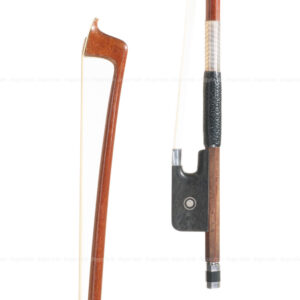How to care for a violin to ensure longevity and maintain exquisite sound quality? Your violin is more than just a musical instrument; it is a work of art and a companion that deserves proper attention and care.
In this comprehensive guide, we’ll walk you through the essential insights and care tips to maintain your violin, keeping it in tip-top shape for years to come.

Daily violin care routine
Maintaining a daily musical instrument care routine is important to preserve the pristine condition and sound quality of your violin. Taking a few simple steps after each playing session can prevent dirt, rosin and oil buildup on the player’s skin from affecting the instrument.
Start by using a soft, lint-free cloth to gently wipe your violin, and we recommend not using any cleaning chemicals, just a dry cloth. This helps remove rosin dust buildup and prevents dust from sticking to the surface of the instrument. Clean the strings and keyboard carefully to ensure optimal sound quality during your next practice or performance. Rosin dust can affect the vibration of the strings, reducing resonance and sound output.
Your bow also needs attention. After a play session, gently clean the bow feathers with a soft cloth to remove excess rosin. Proper hair care is essential to maintain the quality of sound produced while playing.

Environmental influence
The condition of your violin is closely tied to the environment in which you reside. Fluctuations in temperature and humidity can have a significant impact on the instrument’s condition, affecting its tone, structure, and overall playability. Protecting your violin from harsh environmental conditions is essential to ensure its longevity and performance.
In an air-conditioned or humidified environment, keeping the humidity consistent will prevent cracks and damage.
Weather changes can have different effects on your violin:
Dimensional changes : Dry weather can cause wood to shrink, changing the height of the top, bridge and neck, while high humidity can have the opposite effect.
Crack: Prolonged exposure to humidity that is too low (below 30%) or too high (above 80%) can lead to excessive shrinkage or expansion of parts, leading to the instrument becoming loose or cracking. especially in vulnerable wood areas like the top.
Sound quality : Very dry environments can produce harsher and harsher sounds, while high humidity produces louder sounds. This also depends on the conditions in which the soundpost of the instrument was initially set up.

How to prevent environmental damage to the violin?
High humidity: If humidity is too high, place your instrument in a storage cabinet, dehumidifier, or at least in a case, use additional bags of desiccant beads, and regularly check to see if the desiccant beads have become cloudy. Is it all tied yet?
Low humidity : Use a humidifier or humidifier designed for string instruments to stabilize humidity.
Maintain humidity at 50-60% to ensure sound quality and optimal conditions for your instrument. Regularly monitoring humidity will protect your violin from problems caused by fluctuating environmental conditions.
Take care of accessory parts
The violin is a stringed instrument with many accessories; Proper care of each individual component is also essential to maintain structural integrity and optimal sound quality.
Bridge care :
The bridge transmits vibrations from the strings to the body of the violin. To ensure stability and avoid warping, make sure the instrument is stored in optimal humidity. The vast majority of bridges are built in a right triangle shape, with the back of the bridge at a 90 degree angle to the surface of the guitar, however some bridges are also built in a regular triangle shape to create structural stability. When you see the bridge deviate from the original angle, pay attention to lifting the strings with your hand and using your thumb to move the bridge back to the correct position. After each playing session, wipe off rosin dust from the strings and bridge.
Soundpost’s location :
The location of the soundpost greatly affects the timbre quality of the instrument. The soundpost is placed under the horse’s feet on the high wire side, about a few millimeters behind the horse and moved inward about 1.5 mm from the edge of the horse’s feet. Adjusting the soundpost should be left to knowledgeable people as it can damage the f-hole or the wood on the inside of the guitar.
Violin string maintenance :
Lubricate the string grooves on the bridge and above the neck with a soft pencil to prolong string life, reduce tension, and protect parts from string bites. The height of the strings relative to the keyboard can be adjusted according to preference; higher strings usually produce a brighter, louder sound. However, strings that are too high can affect pressing technique. Changing violin strings regularly is essential to maintain sound quality and playability. Frequency varies based on usage and factors such as rosin buildup, perspiration, and string material. Professional musicians may change their strings monthly, while more casual players may do so every 3 to 6 months.

Herd storage
Properly storing your violin is very important to preserve its longevity. Choose a suitable violin case to protect your instrument. The sturdy and well-padded shell protects against physical impacts as well as fluctuations in temperature and humidity.
Store your violin in a cabinet when not in use to protect it from the elements.
Pay attention to your regular inspection and repair schedule. Professional maintenance is essential to resolve potential problems and maintain your violin’s performance. Regularly scheduling visits to a skilled luthier is prudent. A luthier can identify small changes in the condition of your instrument that may affect its sound quality and playability.
Your violin is more than just a musical instrument; it is a treasure that deserves careful care and attention. Remember that daily care habits, awareness of environmental factors, proper handling and placement, and regular professional maintenance are the foundation for preserving your instrument.
Based on Amorim Fine Violin







